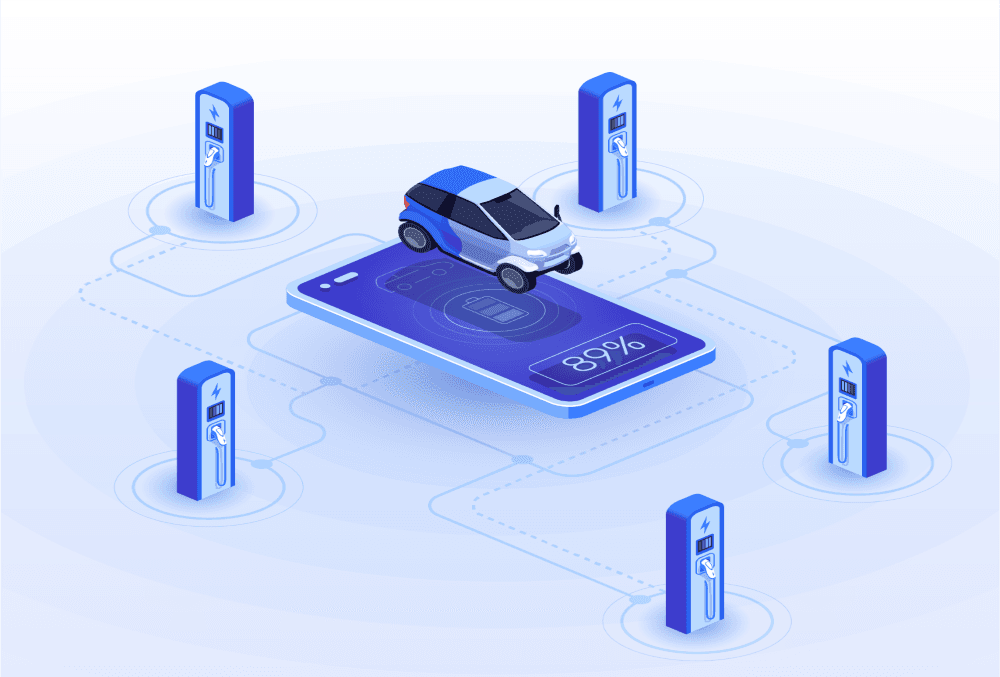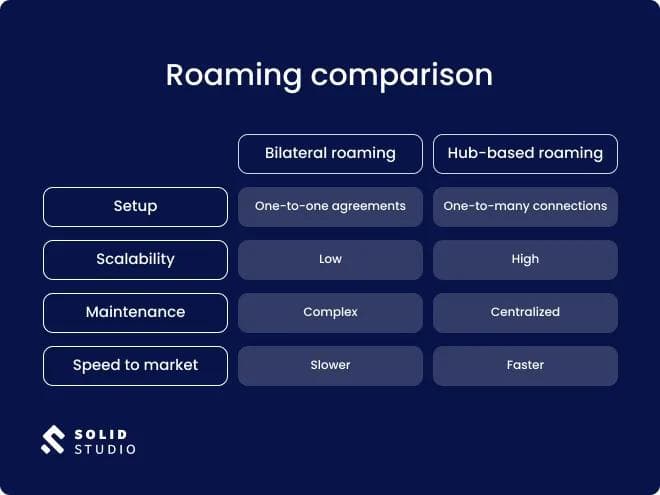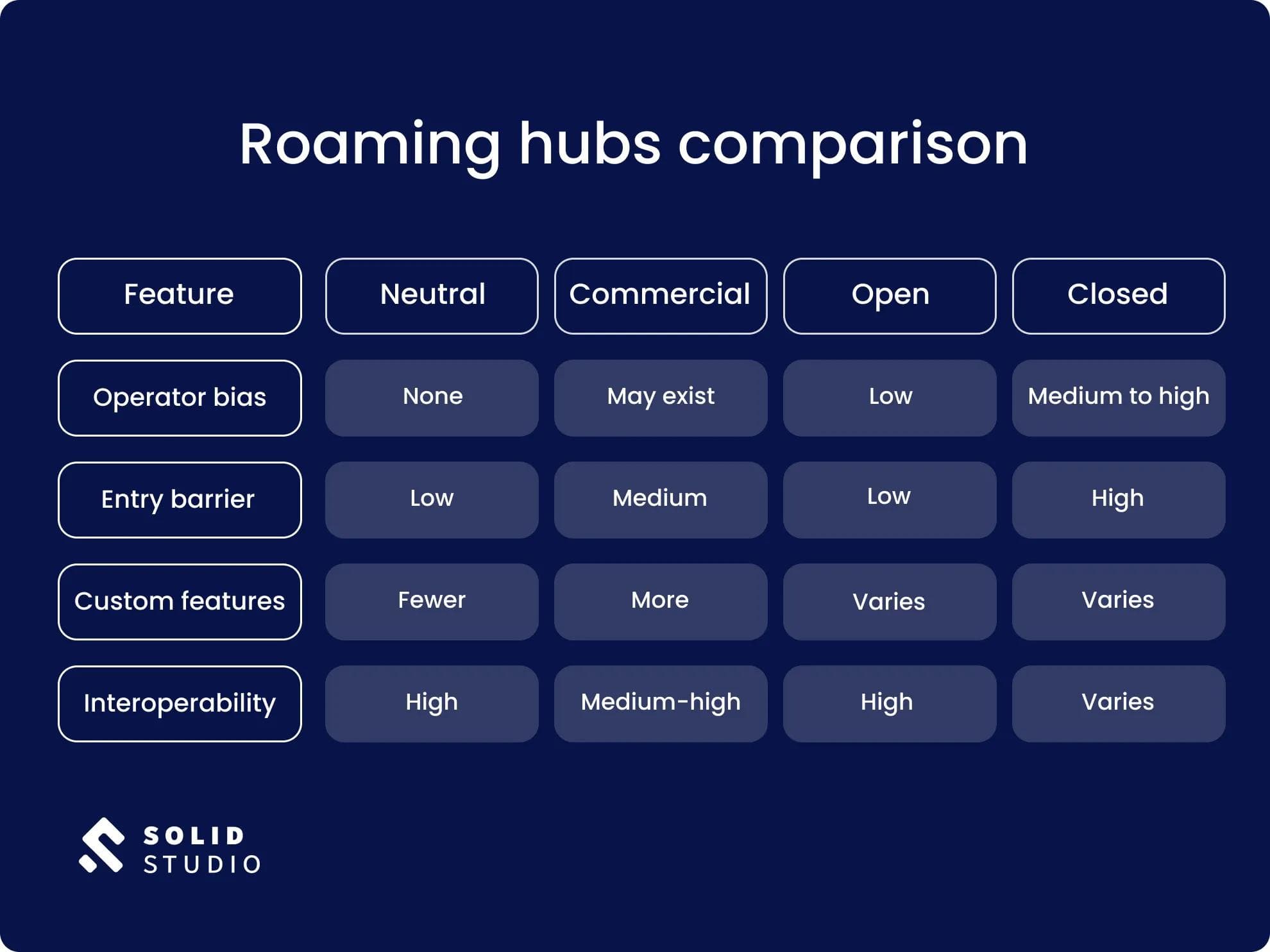If you’ve ever driven your electric vehicle beyond your home network, maybe on a weekend trip or across the border, you’ve probably noticed how charging can suddenly become complicated. One app works at home, but not abroad. One charging station needs a different RFID card. It’s not always seamless.
That’s where roaming hubs come in.
Roaming hubs help simplify this messy experience by connecting charging networks behind the scenes. They make it possible for EV drivers to plug in and charge without needing a new app or contract for every provider. And for businesses in the EV ecosystem, they reduce the technical and commercial hassle of managing dozens of separate roaming agreements.
In this article, we’ll break down what roaming hubs are, how they work, and why they’re becoming essential for a more connected, user-friendly EV charging experience.
👉 Want the full picture? Download our free ebook: eRoaming Hubs Explained to dive deeper into the technical and strategic side of eRoaming.
What is a roaming hub?
A roaming hub is a digital platform that connects different EV charging networks, making it easier for them to communicate and share access with one another.
Instead of building and maintaining one-to-one (bilateral) connections between every CPO and eMSP, a roaming hub acts as a central connector where multiple players plug in once and automatically become interoperable with others on the network.
In simple terms:
- A CPO connects to a roaming hub → they become accessible to many eMSPs.
- An eMSP connects to the same hub → their users can access a wide network of charging stations.
This setup drastically reduces the effort and cost of creating separate agreements with every partner. It also accelerates market growth by enabling broader access and smoother user experiences.
What are the key functions of a roaming hub?
- It facilitates the authentication and authorization of EV drivers
- It handles charging session data exchange (start/stop times, energy consumed, location, etc.)
- It supports billing and settlement between networks
- It’s often built on standard protocols like OCPI or OICP
How roaming hubs fit into the eRoaming ecosystem
To understand the role of roaming hubs, it's helpful to zoom out and look at the bigger picture: the eRoaming ecosystem.
What is eRoaming?
eRoaming lets EV drivers use charging stations from different networks without signing up for a new app or contract each time. It allows drivers to charge across countries and providers as if everything were part of one big network.
In short, it makes charging your EV on the go, especially across borders, simple and connected.
There are two main ways this interoperability is achieved:
1. Bilateral roaming
- Direct agreements between two companies (e.g., CPO ↔ eMSP)
- Requires custom integration for each new partner
- Scales poorly as the number of partners grows
2. Hub-based roaming
- All parties connect to a central roaming hub
- Each new connection automatically links to all others on the hub
- More scalable, efficient, and easier to manage
Here’s a quick comparison:
The EV ecosystem is expanding fast, and so is the number of CPOs and eMSPs. Roaming hubs help untangle the web of partnerships by offering a scalable, interoperable foundation for all players.
Instead of juggling dozens of integrations, businesses can focus on improving the charging experience, while the hub handles the connectivity.
Why roaming hubs matter
Roaming hubs are a critical enabler of smoother EV charging experiences and faster market expansion. Here's how they add value to each part of the EV ecosystem:
For charge point operators: Faster market reach
- Instant access to more users: By connecting to a roaming hub, CPOs make their stations available to dozens (or hundreds) of eMSPs at once.
- Lower integration costs: No need to build and maintain one-to-one connections.
- Simplified billing and reporting: Hubs often standardize session data and settlements.
Example: A small regional CPO plugs into a roaming hub and instantly becomes visible to international drivers using major eMSP apps.
For eMobility service providers: Competitive advantage
- Broader station availability: Offer customers access to more chargers without building new partnerships one by one.
- Improved customer satisfaction: Less friction = more charging confidence = stronger user retention.
- Faster expansion: Launch in new markets without the need for local agreements in place first.
Example: An eMSP can expand its app’s coverage overnight by connecting to a hub already populated with hundreds of CPOs.
For EV drivers: Less hassle, more access
- One app, more stations: No need to juggle multiple accounts or RFID cards.
- Cross-border charging: Roaming hubs make it easier to charge across different countries and networks.
- Reliable coverage: Better network reach means fewer dead zones and more confidence on the road.
Example: A driver from Germany using one eMSP app can charge in France or the Netherlands through a roaming hub connection, without switching providers.
Shared benefits across the ecosystem
- Scalability: One connection opens many doors.
- Interoperability: Common protocols and standards reduce technical friction.
Innovation-ready: Easier adoption of services like Plug & Charge, smart charging, or real-time station data.
Common challenges with roaming hubs
While roaming hubs offer major advantages in scalability and convenience, they’re not without their technical, commercial, and operational hurdles. Understanding these challenges is key to making informed decisions about joining or integrating with a hub.
1. Protocol compatibility and technical complexity
Most roaming hubs rely on standard communication protocols, like OCPI (Open Charge Point Interface) or OICP (Open InterCharge Protocol). But:
- Not all CPOs and eMSPs are using the same protocol versions.
- Custom implementations can lead to compatibility issues
- Initial integration can require heavy technical effort, especially for companies with legacy systems.
💡 Tip: Choosing a hub that supports open, well-documented, and actively maintained protocols reduces the long-term burden.
2. Data quality and real-time accuracy
Roaming hubs depend on clean, consistent, and real-time data to deliver a seamless experience. However:
- Station status updates may lag.
- Incorrect location or pricing data can frustrate drivers.
- Session start/stop errors create billing disputes.
🚨Poor data leads to broken user experiences even when the underlying network is strong.
3. Commercial agreements and transparency
Each roaming hub operates with its own business model. Key pain points include:
- Lack of pricing transparency for charging sessions.
- Complex revenue-sharing agreements.
- Limited control over how stations are listed or prioritized in partner apps.
🚨Evaluate not just the technical features of a hub, but also its commercial model and how it aligns with your business goals.
4. Vendor lock-in and limited flexibility
Some hubs operate with closed ecosystems or require long-term commercial commitments.
- Switching hubs can be difficult once deeply integrated.
- It may be hard to interconnect with networks outside of that ecosystem.
🚨Make sure the hub you choose doesn’t limit your future interoperability or strategic growth options.
5. Fragmentation in the roaming landscape
Despite their promise of unification, the roaming hub space itself is fragmented. With multiple major hubs (e.g., Hubject, Gireve, e-clearing.net), businesses often have to:
- Choose between hubs or
- Connect to multiple hubs to achieve full coverage
🚨Some companies use hub-to-hub interconnections to extend reach, but this introduces new layers of complexity.
Understanding these trade-offs helps you weigh scalability against control and reliability, and prepare for smoother integrations.
Types of roaming hubs: What’s out there and how they differ
Not all roaming hubs are built the same. Depending on their structure, business model, and level of openness, the experience and value can vary significantly for CPOs, eMSPs, and even end users.
Here’s how to navigate the key categories:
1. Neutral vs. commercial roaming hubs
Neutral hubs
- Operated by independent entities with no direct stake in charging or mobility services.
- Aim to create a level playing field for all market participants.
- Focus on transparency, interoperability, and open standards.
Example:
- e-clearing.net – non-profit foundation, protocol-agnostic, governance-driven.
Commercial hubs
- Operated by for-profit companies, sometimes backed by major automotive or energy players.
- May offer premium services, tighter integrations, or bundled offerings with their platforms.
Examples:
- Hubject, backed by OEMs and utilities, widely used in Europe.
- Gireve – commercial operator with a strong presence in France and the surrounding regions.
💡Tip: Neutral hubs may offer more flexibility and transparency, while commercial hubs can deliver speed, scale, and richer tooling but may involve lock-in.
2. Open vs. closed network ecosystems
Open hubs
- Anyone (who meets the technical and commercial criteria) can join.
- More transparent processes for onboarding and data handling.
- Typically aligned with industry standards like OCPI.
Closed hubs
- Require formal membership, approvals, or specific commercial terms.
- May restrict access to certain partners or regions.
- Sometimes, favor preferred partners in terms of visibility or data access.
💡Tip: For startups or smaller players, open hubs may lower the barrier to entry. Closed ecosystems may work better for established companies prioritizing security, scale, or market control.
3. Single hub vs. hub-to-hub connectivity
- Some hubs focus on creating a single, unified network.
- Others develop inter-hub connections, allowing cross-hub roaming (e.g., Hubject ↔ Gireve).
- (+) Access to a broader market through fewer integrations.
- (-) More complex billing chains and potential latency or data sync issues.
Roaming hubs comparison table
How to choose the right roaming hub
Choosing the right roaming hub is a strategic decision. Whether you're a CPO looking to scale access to your chargers or an eMSP wanting broader station coverage, the hub you choose will shape your operations, partnerships, and customer experience.
Here’s a framework to help guide that choice:
1. Assess your business goals
Start with your strategic priorities:
- Expanding coverage quickly? Look for hubs with a large, existing network.
- Maintaining flexibility and control? A neutral or open hub might suit better.
- Targeting specific markets (e.g., France, Germany)? Choose a hub with a strong regional presence.
💡Tip: Gireve is particularly strong in France; Hubject has wide coverage across Europe.
2. Evaluate technical fit
- What protocol do you use? (e.g., OCPI, OICP)
- Does the hub support your existing version?
- Is the onboarding process well-documented and supported?
Consider:
- Data format consistency
- API responsiveness and uptime
- Real-time data flow and error handling
💡Tip: Ask for a sandbox/test environment before committing.
3. Understand pricing and commercial models
- What are the setup fees, per-session fees, and monthly costs?
- Are billing and revenue splits transparent?
- Does the hub lock you into long-term agreements?
Beware of:
- Hidden costs in session settlement
- Limited visibility into what other partners are charging your users
💡Tip: Download our ebook, 10 Inconvenient Questions You Should Ask Your EV Charging Management Provider, to know exactly what to focus on.
4. Check market coverage and growth potential
- How many CPOs or eMSPs are already connected?
- Are those partners active in your key markets?
- Does the hub have plans for inter-hub connectivity or international expansion?
💡Tip: Ask for a list of live roaming partners (or coverage map).
5. Analyze openness and vendor lock-in
- Can you connect to other hubs in parallel?
- Does the hub restrict your ability to work outside its network?
- Is there a simple offboarding process?
Look for:
- Non-exclusive agreements
- Open standards and easy switching paths
6. Request references or case studies
Ask for:
- Integration timelines
- Uptime statistics
- Examples of similar-sized companies using the hub successfully
This is especially helpful if you're early-stage and want to benchmark expected ROI and integration effort.
Roaming hubs: What’s coming?
As the EV charging market matures, roaming hubs will continue evolving, not just as connection points, but as strategic enablers of next-generation charging experiences.
Here are the key trends shaping the future of roaming hubs:
1. Plug & Charge becomes the new standard
Thanks to ISO 15118, Plug & Charge enables EVs to automatically authenticate and start charging - no app, card, or manual login needed.
Roaming hubs will play a critical role in managing digital certificates, secure authentication, and cross-network validation.
💡Tip: Hubs that support Plug & Charge early will give CPOs and eMSPs a competitive edge.
2. Smarter data, smarter charging
As hubs collect and exchange more real-time data, there’s growing potential for:
- Dynamic pricing based on grid load
- Predictive maintenance using usage analytics
- Enhanced routing and availability predictions for EV drivers
Roaming hubs are well-positioned to become central data coordinators in a more intelligent, demand-responsive charging network.
3. Inter-hub roaming expansion
Fragmentation still exists, but hub-to-hub integrations are accelerating. Expect to see:
- More cross-hub roaming agreements (e.g., Hubject ↔ Gireve)
- Greater interoperability across continents
- Consolidation of roaming platforms to simplify entry for new players
4. Stronger emphasis on open standards
With widespread adoption of OCPI and the rise of open-source implementations, future hubs will likely be:
- More transparent
- Easier to integrate with
- Less reliant on proprietary logic
This shift benefits everyone, especially smaller CPOs and eMSPs looking to compete with limited resources.
5. Roaming beyond EVs
While EV charging is the primary focus today, the architecture behind roaming hubs could expand into:
- Micromobility (e-scooters, e-bikes)
- Vehicle-to-grid (V2G) services
- Energy-as-a-Service platforms
The lines between energy, mobility, and digital infrastructure are blurring, and roaming hubs are right at the intersection.
Roaming hubs have already changed how EV drivers charge. Over the next few years, they’ll help shape how we power, price, and plan mobility at a system level.
Ready to simplify roaming? Let’s make it work together
Roaming doesn’t have to be complicated. Whether you’re struggling with protocol compatibility, integration complexity, or choosing the right hub, the key is having the right technology partner.
At Solidstudio, we’ve helped CPOs and eMSPs across Europe design, build, and scale their eRoaming strategies from OCPI integrations to hub connectivity and custom backend solutions.
We understand the pain points: scattered systems, data mismatches, uncertainty about where to start. And we’re here to help you cut through the noise with practical, future-ready solutions.
👉 Need to connect to a roaming hub?
👉 Trying to navigate OCPI or improve your existing integration?
👉 Planning to expand to new markets through interoperability?
Let’s talk.
Book a free consultation to explore how we can support your next step in the EV ecosystem.
FAQs: Roaming hubs in EV charging
What is a roaming hub in EV charging?
A roaming hub is a digital platform that connects different electric vehicle (EV) charging networks. It enables Charge Point Operators (CPOs) and eMobility Service Providers (eMSPs) to share access, so EV drivers can charge their vehicles at more stations without needing separate apps or accounts for each provider.
How does a roaming hub work?
Roaming hubs act as a central connector. When a CPO and an eMSP both connect to the same hub, their systems become interoperable. This means EV drivers using one eMSP’s app can access charging stations from multiple CPOs seamlessly, without extra logins or contracts.
Why are roaming hubs important for EV drivers?
Roaming hubs make EV charging more convenient by allowing cross-network and cross-border charging with a single app or RFID card. They help eliminate "dead zones" where users can’t charge and improve confidence during long-distance or international trips.
What is the difference between bilateral roaming and hub-based roaming?
- Bilateral roaming requires one-to-one agreements between providers, which don’t scale well.
- Hub-based roaming connects many CPOs and eMSPs through a central platform, offering faster setup, better scalability, and simplified integration.
What protocols do roaming hubs use?
Most roaming hubs rely on standard protocols like OCPI (Open Charge Point Interface) or OICP (Open InterCharge Protocol). These enable secure data exchange for authentication, session tracking, and billing.
What challenges come with using roaming hubs?
Common issues include:
- Protocol incompatibility between networks
- Poor data quality or outdated station info
- Lack of pricing transparency
- Risk of vendor lock-in
- Fragmentation due to multiple hub providers
How do I choose the right roaming hub for my business?
Consider:
- Your business goals (speed to market, flexibility, regional focus)
- Technical compatibility (protocols, APIs, data flow)
- Pricing and transparency
- Existing partner network
- Long-term interoperability and vendor neutrality
What’s the difference between neutral and commercial roaming hubs?
- Neutral hubs (like e-clearing.net) are non-profit and promote open access and transparency.
- Commercial hubs (like Hubject or Gireve) are for-profit and may offer faster onboarding or bundled services, but often with less flexibility.
What’s the future of roaming hubs?
Trends include:
- Support for Plug & Charge (ISO 15118)
- Smarter charging with real-time data analytics
- More hub-to-hub interoperability
- Greater use of open standards like OCPI
- Expansion into new areas like micromobility and energy services
Can roaming hubs help with international EV charging?
Yes. Roaming hubs simplify cross-border charging by connecting networks across countries, allowing EV drivers to use their home eMSP app while traveling abroad.



